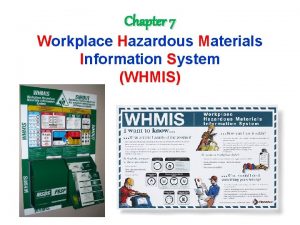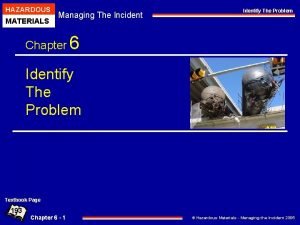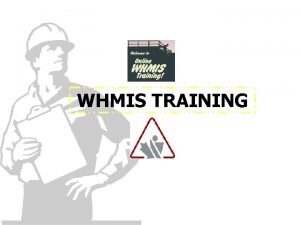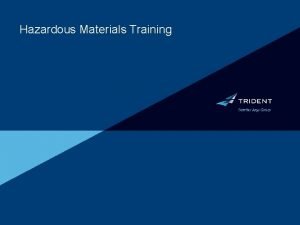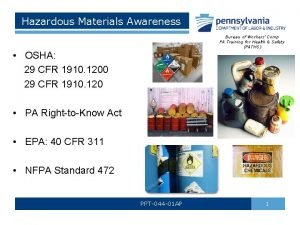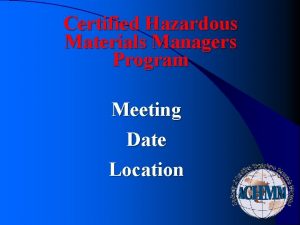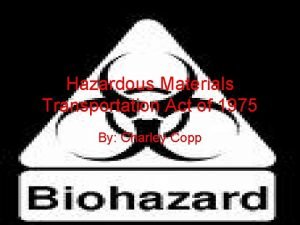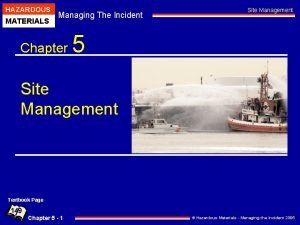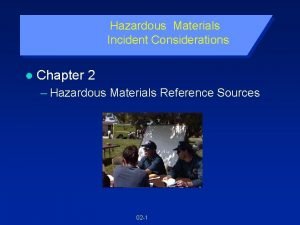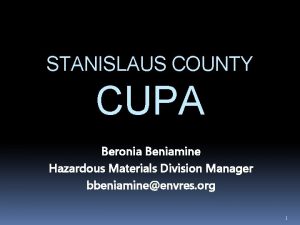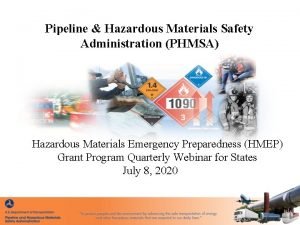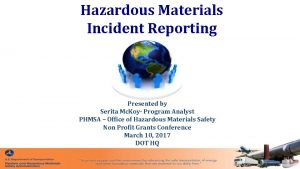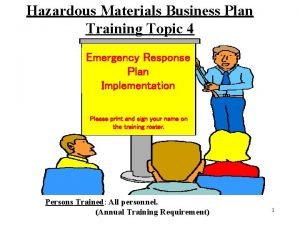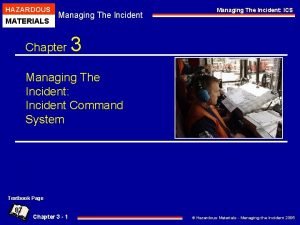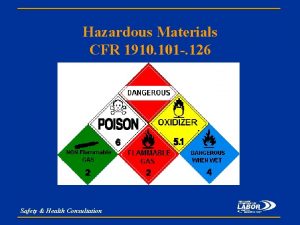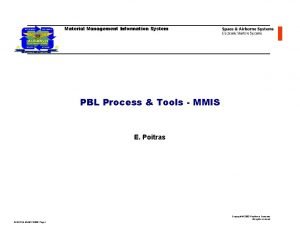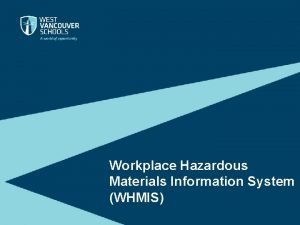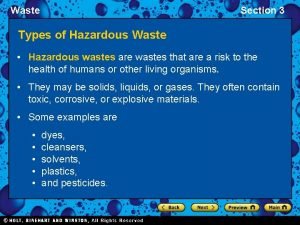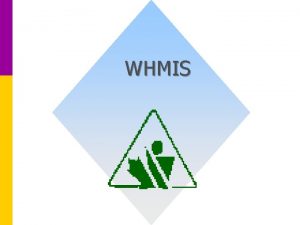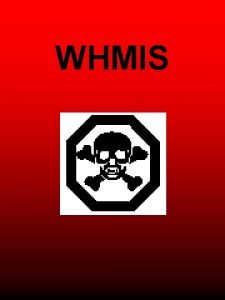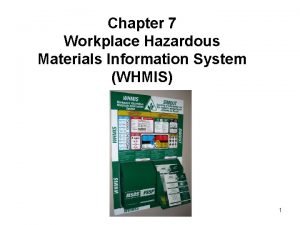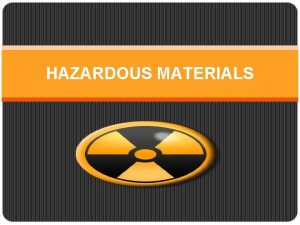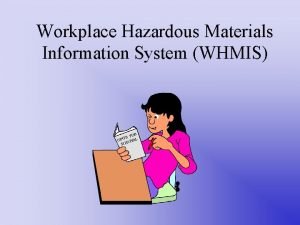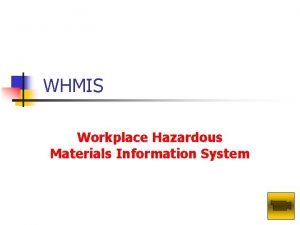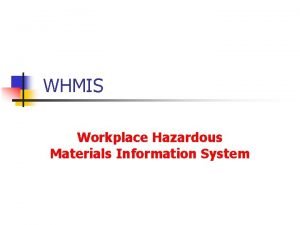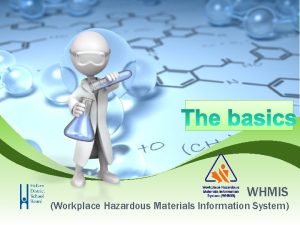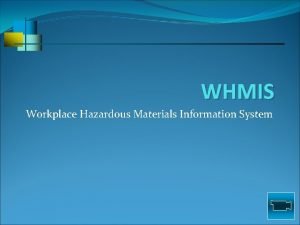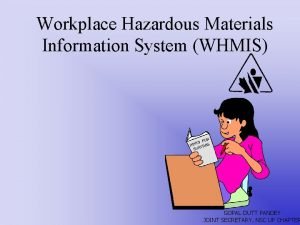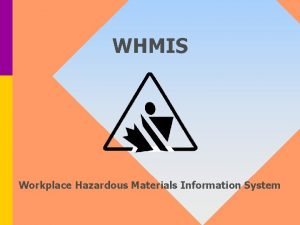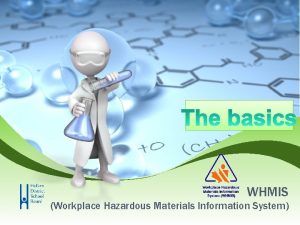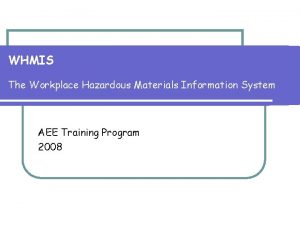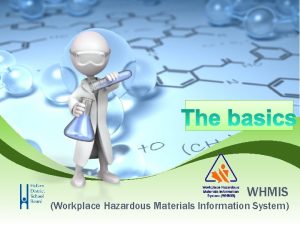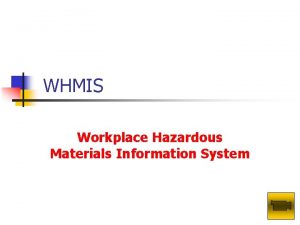Chapter 7 Workplace Hazardous Materials Information System WHMIS



























- Slides: 27

Chapter 7 Workplace Hazardous Materials Information System (WHMIS) 1

What is WHMIS? q It is a system designed to ensure that all employers obtain the information that they need to inform and train their employees properly about hazardous materials used in the workplace. q WHMIS is consistent with the worker's "right to know" more about safety and health hazards of materials used in the workplace. q WHMIS only applies to products that meet certain criteria, referred to as controlled products. 2

WHMIS comprises three major elements: 1) Labels 2) Material Safety Data Sheets (MSDSs) 3) Worker Education WHMIS labels provide the essential information that a person needs in order to handle a particular product safely. MSDSs provide Basic technical information about a product's physical characteristics and its hazardous properties. The Worker Education element ensures that workers are able to apply the information to protect worker health and safety. 3

1. Labels • Supplier labels provide seven (7) pieces of information: 1. Product Identification (brand name, code name or chemical name) 2. WHMIS Hazard Symbols for each of product's hazard classes 3. Risk Phrases (examples) 4. Precautionary Statements - these are precautions to be taken when using or being exposed to the product (examples) 5. First Aid Measures 6. a statement advising that a MSDS is available 7. Manufacturer and Supplier (Name and Address) 4

2. Material Safety Data Sheets (MSDSs) – – – – – Product Information Hazardous Ingredients Physical Data Fire or Explosion Hazard Reactivity Data Toxicological Properties (health effects) Preventive Measures First Aid Measures Preparation Information 5

Chapter 6 Material Safety Data Sheet 6

What is a Material Safety Data Sheet (MSDS)? • MSDS used to assess the physical and health hazards of the chemical or product. • MSDSs must be obtained and maintained for every chemical used in the workplace. • The Laboratory Standard requires laboratories to keep Material Safety Data Sheets (MSDSs) that are received from the manufacturer. • The MSDSs must be accessible to all personnel during their work hours. What to do with MSDSs and where to find them? Many MSDSs are available via the World Wide Web. 7

Understanding MSDS information (1) Chemical product and company identification. (2) Hazardous Ingredients (3) hazards identification (4) First Aid measures (5) Fire fighting measures (6) Accidental release measures (7) Handling and storage (8) Exposure controls/personal protection (9) Physical and chemical properties (10) Stability and reactivity (11) Toxicological information (12) Ecological information (13) Disposal consideration (14) Transport Information (15) Regulatory information (16) Other information (17) Lable information 8

3. Worker Education • • All persons who work with controlled products must be provided with WHMIS worker education. WHMIS Worker Education includes four (4) areas of instruction: – WHMIS Labels and MSDSs – Hazard Information – Identification Codes – Procedures for safe use, storage and handling and disposal of controlled products. 9

Controlled Products • WHMIS applies only to controlled products, those that meet certain criteria. There are six (6) classes of controlled products (see WHMIS Hazard Classes) and include: – – – Compressed Gas Flammable and Combustible Material Poisonous and Infectious Material Corrosive Material Dangerously Reactive Material 10

Exemptions from WHMIS Legislation • The following products are excluded from all aspects of WHMIS legislation: • • • Wood and products made of wood Tobacco and products made of tobacco Manufactured articles Dangerous materials while they are covered by TDG legislation (while in transit) Hazardous wastes (except that safe storage and handling are required) The following list of products are excluded from the supplier aspects of WHMIS: • • • Explosives Cosmetics, devices, foods and drugs Pesticides and herbicides Radioactive materials Consumer products 11

12

Hazards Symbols The WHMIS system groups hazards materials into six classes or categories based on the type of hazard which they represent. Each category has its own hazards symbol and it is important that the worker be able to recognize these. 13

WHMIS Hazard Symbols 14

a 15

Hazards Symbols A- Compressed Gas § A compressed gas is a material which is a gas at normal room temperature (20°C) and pressure, but is package as a pressured gas, dissolved gas or gas qualified by compression or refrigeration. § The hazard from these materials, aside from their chemical nature, arises from sudden loss of integrity of the container. § A compressed gas cylinder is usually quite heavy and when ruptured can become a projectile with the potential to cause significant damage. § Acetylene and oxygen are examples of compressed gases. 16

Hazards Symbols B- Flammable and Combustible Materials § Flammable or combustible materials with ignite and continue to burn if exposed to a flame or source of ignition. § Materials are classified as a flammable gas, flammable aeresol, flammable liquid, combustible liquid, flammable solid, or reactive flammable material. § Methane, acetone, aniline, and lithium hydride are examples of flammable materials. 17

Hazards Symbols C- Oxidizing Materials § An oxidizing material may or may not burn itself, but will release oxygen or another oxidizing substance, and thereby causes or contributes to the composition of another material. § Ozone, chlorine, and nitrogen dioxide are oxidizing materials. § These chemicals will support a fire and are highly reactive. 18

Hazards Symbols D- Poisonous and Infectious Materials D 1 - Materials Causing Immediate and Serious Toxic Effects § These materials may be classified as toxic or very toxic, based on information such as LD 50 or LC 50. § For examples, styrene, hydrogen cyanide are very toxic substances. 19

Hazards Symbols D- Poisonous and Infectious Materials D 2 - Materials Causing other Toxic Effects § A pure substance or mixture that may be any one of the following: a carcinogen, teratogen, reproductive toxin, respiratory tract sensitizer, irritant or chronic toxic hazard. § Examples: Aspestos causes cancer, ammonia is an irritant. 20

Hazards Symbols D- Poisonous and Infectious Materials D 3 - Biohazards Infection Materials § This classification includes any organisms and the toxins produced by these organisms that have been showed to cause disease or are believed to cause disease in either humans or animals. § For example, a blood sample containing the Hepatitis B virus is a biohazard infectious material. It may caused Hepatitis in persons when exposed to it. 21

Hazards Symbols E- Corrosive Materials § Corrosive material can attack (corrode) metals or cause permanent damage to human tissues such as the skin and eyes on contact. Burning, scarring, and blindness may result from skin or eye contact. § Corrosive materials may also cause metal containers or structural materials to become weak and eventually. 22

Hazards Symbols F- Dangerous Reactive Materials § Dangerously reactive materials may undergo vigorous polymerization, decomposition or condensation. § They may react violently under conditions of shock or an increase in pressure or temperature. § They also may react vigorously with water to release a toxic gas. § Ozone, hydrazine, and benzoyl peroxide are examples of dangerously reactive materials. 23

Define each of the following hazard symbols 24

25

Meaning of shape and color of Hazard Symbols 26

27
 Workplace hazardous materials information system symbols
Workplace hazardous materials information system symbols Us military marking system for hazardous materials
Us military marking system for hazardous materials 3 basic components of whmis
3 basic components of whmis Hazmat table
Hazmat table Hazardous materials table
Hazardous materials table Hazwoper
Hazwoper Isachmm
Isachmm Hazardous materials transportation act of 1975
Hazardous materials transportation act of 1975 Hazardous materials managing the incident
Hazardous materials managing the incident Hazardous materials reference books
Hazardous materials reference books Stanislaus county hazardous materials division
Stanislaus county hazardous materials division Pipeline and hazardous materials administration
Pipeline and hazardous materials administration Hazardous materials incident report
Hazardous materials incident report Hazardous materials business plan
Hazardous materials business plan Hazardous materials managing the incident
Hazardous materials managing the incident Compressed gas association pamphlet p-1-1965
Compressed gas association pamphlet p-1-1965 Material information system
Material information system What does ghs stand for in whmis
What does ghs stand for in whmis Cant stop the feeling trolls go noodle
Cant stop the feeling trolls go noodle Identifying useful and harmful materials
Identifying useful and harmful materials Man made map
Man made map Adapting and adopting materials
Adapting and adopting materials Direct materials budget with multiple materials
Direct materials budget with multiple materials Section 3 hazardous waste answers
Section 3 hazardous waste answers Aviation hazardous attitudes
Aviation hazardous attitudes Dr neha agrawal
Dr neha agrawal Five hazardous attitudes
Five hazardous attitudes 5 hazardous attitudes
5 hazardous attitudes
